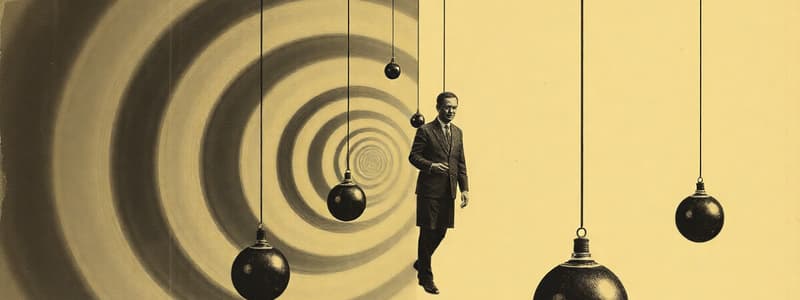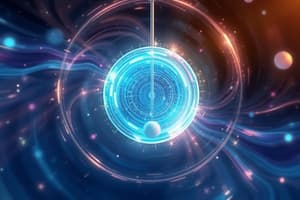Podcast
Questions and Answers
In the context of oscillations, what fundamentally distinguishes forced oscillations from free oscillations?
In the context of oscillations, what fundamentally distinguishes forced oscillations from free oscillations?
- Forced oscillations occur in a vacuum, eliminating damping, while free oscillations always experience damping forces.
- Forced oscillations involve an external periodic force that continuously drives the system, whereas free oscillations are governed only by the system’s internal restoring force. (correct)
- Forced oscillations are solely determined by the system's internal restoring force, while free oscillations require an external periodic force.
- Forced oscillations maintain a constant amplitude indefinitely, whereas free oscillations gradually increase in amplitude over time.
How does increased air resistance primarily affect a mechanical oscillating system, such as a pendulum swinging in air?
How does increased air resistance primarily affect a mechanical oscillating system, such as a pendulum swinging in air?
- It converts the kinetic energy of the pendulum into potential energy, causing the pendulum to swing longer.
- It results in damped oscillations, gradually reducing the energy and amplitude of the oscillations over time. (correct)
- It increases the frequency of the oscillations, causing the pendulum to swing faster.
- It causes resonance, leading to a rapid increase in the amplitude of the oscillations.
Considering a simple pendulum undergoing simple harmonic motion (SHM), how does the period ($T$) change if the length ($L$) of the pendulum is quadrupled?
Considering a simple pendulum undergoing simple harmonic motion (SHM), how does the period ($T$) change if the length ($L$) of the pendulum is quadrupled?
- The period ($T$) is halved.
- The period ($T$) remains the same.
- The period ($T$) is quadrupled.
- The period ($T$) is doubled. (correct)
A mass-spring system oscillates vertically. How does increasing the mass affect the system's frequency and period, assuming the spring constant remains unchanged?
A mass-spring system oscillates vertically. How does increasing the mass affect the system's frequency and period, assuming the spring constant remains unchanged?
In the context of oscillations, what is the significance of 'phase' and 'phase difference' when comparing two sinusoidal oscillations?
In the context of oscillations, what is the significance of 'phase' and 'phase difference' when comparing two sinusoidal oscillations?
What is the key distinction between 'translational (linear) oscillations' and 'angular (rotational) oscillations'?
What is the key distinction between 'translational (linear) oscillations' and 'angular (rotational) oscillations'?
How do 'damped oscillations' differ from 'undamped oscillations' in terms of energy conservation and the presence of external forces?
How do 'damped oscillations' differ from 'undamped oscillations' in terms of energy conservation and the presence of external forces?
In medicine, how do 'damped oscillations' manifest in the regulation of blood pressure following a disturbance, such as exercise?
In medicine, how do 'damped oscillations' manifest in the regulation of blood pressure following a disturbance, such as exercise?
What biophysical principle underlies the use of 'undamped oscillations' in Magnetic Resonance Imaging (MRI) radiofrequency (RF) pulses?
What biophysical principle underlies the use of 'undamped oscillations' in Magnetic Resonance Imaging (MRI) radiofrequency (RF) pulses?
When analyzing human gait as an oscillatory motion, how does the concept of a 'pendulum' apply to the movement of legs during walking?
When analyzing human gait as an oscillatory motion, how does the concept of a 'pendulum' apply to the movement of legs during walking?
In designing a high-frequency oscillatory ventilator (HFOV) for neonates with underdeveloped lungs, which oscillation parameter is most crucial to optimize in order to minimize lung injury while improving oxygenation?
In designing a high-frequency oscillatory ventilator (HFOV) for neonates with underdeveloped lungs, which oscillation parameter is most crucial to optimize in order to minimize lung injury while improving oxygenation?
During diagnostic ultrasound imaging, how do the oscillations of a piezoelectric crystal within the ultrasound probe contribute to creating images of internal organs?
During diagnostic ultrasound imaging, how do the oscillations of a piezoelectric crystal within the ultrasound probe contribute to creating images of internal organs?
Which physiological mechanism primarily explains how the typical heartbeat is best described as a 'damped, nonlinear biological oscillation'?
Which physiological mechanism primarily explains how the typical heartbeat is best described as a 'damped, nonlinear biological oscillation'?
How does the principle of resonance relate to arterial resonance and what implications does it have for circulatory function?
How does the principle of resonance relate to arterial resonance and what implications does it have for circulatory function?
Given the formula for angular natural frequency ($\omega_0 = \sqrt{\frac{g}{L}}$) of a simple pendulum, how would you modify the length (L) to halve its angular natural frequency, assuming g remains constant?
Given the formula for angular natural frequency ($\omega_0 = \sqrt{\frac{g}{L}}$) of a simple pendulum, how would you modify the length (L) to halve its angular natural frequency, assuming g remains constant?
Given that the period of a mass-spring system is described by $T = 2\pi\sqrt{\frac{m}{k}}$, what adjustment to the spring constant ($k$) would double the period ($T$) of the oscillation, assuming the mass ($m$) remains constant?
Given that the period of a mass-spring system is described by $T = 2\pi\sqrt{\frac{m}{k}}$, what adjustment to the spring constant ($k$) would double the period ($T$) of the oscillation, assuming the mass ($m$) remains constant?
If the equation for simple harmonic motion is given by $x = A \cos(\omega_0 t + \phi_0)$, how does increasing the initial phase angle $\phi_0$ affect the starting position ($x$ at $t=0$) of the oscillating object?
If the equation for simple harmonic motion is given by $x = A \cos(\omega_0 t + \phi_0)$, how does increasing the initial phase angle $\phi_0$ affect the starting position ($x$ at $t=0$) of the oscillating object?
Considering the equation of motion for a damped oscillator, what role does the damping coefficient play in determining the long-term behavior of the system?
Considering the equation of motion for a damped oscillator, what role does the damping coefficient play in determining the long-term behavior of the system?
What is the primary distinction between the mechanisms underlying 'falsetto' and 'modal' voice production in the context of vocal fold oscillations?
What is the primary distinction between the mechanisms underlying 'falsetto' and 'modal' voice production in the context of vocal fold oscillations?
In analyzing respiratory patterns, how can abnormal oscillation patterns, such as Cheyne-Stokes respiration, aid in diagnosing underlying medical conditions?
In analyzing respiratory patterns, how can abnormal oscillation patterns, such as Cheyne-Stokes respiration, aid in diagnosing underlying medical conditions?
If a simple pendulum and spring pendulum are set up to explore oscillations, what adjustments could be made to ensure that both systems oscillate with almost identical periods, and what does this indicate?
If a simple pendulum and spring pendulum are set up to explore oscillations, what adjustments could be made to ensure that both systems oscillate with almost identical periods, and what does this indicate?
Flashcards
Oscillation
Oscillation
Repetitive back-and-forth movement of an object around a central point.
Free Oscillations
Free Oscillations
Oscillations driven by the system's internal restoring force.
Damped Oscillations
Damped Oscillations
Oscillations where resistive forces cause energy loss over time.
Forced Oscillations
Forced Oscillations
Signup and view all the flashcards
Resonant Oscillations
Resonant Oscillations
Signup and view all the flashcards
Mechanical Oscillations
Mechanical Oscillations
Signup and view all the flashcards
Electrical Oscillations
Electrical Oscillations
Signup and view all the flashcards
Electromagnetic Oscillations
Electromagnetic Oscillations
Signup and view all the flashcards
Translation Oscillations
Translation Oscillations
Signup and view all the flashcards
Angular Oscillations
Angular Oscillations
Signup and view all the flashcards
Simple Harmonic Motion (SHM)
Simple Harmonic Motion (SHM)
Signup and view all the flashcards
Heartbeat oscillation
Heartbeat oscillation
Signup and view all the flashcards
Damped Oscillation
Damped Oscillation
Signup and view all the flashcards
Pendulum Length
Pendulum Length
Signup and view all the flashcards
L
L
Signup and view all the flashcards
Pendulum Period
Pendulum Period
Signup and view all the flashcards
T
T
Signup and view all the flashcards
Angle of Displacement
Angle of Displacement
Signup and view all the flashcards
Heartbeat as Oscillator
Heartbeat as Oscillator
Signup and view all the flashcards
Plot scatter graph
Plot scatter graph
Signup and view all the flashcards
Measurements
Measurements
Signup and view all the flashcards
Relative Error
Relative Error
Signup and view all the flashcards
HFOV
HFOV
Signup and view all the flashcards
Human Gait
Human Gait
Signup and view all the flashcards
Study Notes
- Oscillations are repetitive back-and-forth movements of an object around a central point or between two states.
- Oscillations can be classified by type of energy, type of motion, and external factors.
- The aim is to explore the parameters affecting the period of oscillations for a simple pendulum and spring pendulum, and to find the free-fall acceleration (g, m/s²) and spring constant (k, N/m).
Oscillation Types by Energy
- Mechanical oscillations involve conversion between kinetic and potential energy.
- Examples: mass-spring system (elastic potential energy) or a simple pendulum (gravitational potential energy).
- Electrical oscillations occur in systems where energy alternates between electric and magnetic fields.
- Typically involve inductors (L) and capacitors (C) in circuits, creating oscillating currents and voltages.
- Electromagnetic oscillations involve the oscillation of electromagnetic fields, where energy propagates as electromagnetic waves.
- Energy alternates between electric and magnetic fields as the wave moves through space.
Oscillation Types by Motion
- Translational (Linear) Oscillations: Displacement of the oscillating object follows a straight line
- Motion is typically harmonic (SHM).
- Example: mass-spring system moving back and forth along a straight path, or a pendulum with small angular displacements.
- Angular (Rotational) Oscillations: Involves the rotation of an object about a fixed axis, restoring torque acts to return the system to equilibrium.
- Displacement is measured in terms of angular displacement (θ).
- Example: torsion pendulum, where a disk or bar twists back and forth around its axis, or a swinging door.
Oscillation Types by External Factors
- Free Oscillations: Motion is determined by the internal restoring force and the system's properties.
- Example: pendulum set into motion and then left to swing freely, or a mass-spring system in a vacuum.
- Damped Oscillations: Occur when resistive forces (friction or air resistance) act on the system, leading to gradual energy loss.
- Forced Oscillations: Occur when an external periodic force continuously drives the system.
- External force supplies energy to sustain the motion, counteracting any damping present.
- Resonant Oscillations: A special type of forced oscillation where the external driving force's frequency matches the system's natural frequency.
- Resonance occurs when an external factor (like a periodic force) synchronizes with the natural frequency.
Oscillations in Medicine
- Heart Rate Variability: The heart exhibits damped oscillatory behavior after disruptions.
- Vibration Response of Bones and Tissues: Oscillatory tests (ultrasound/mechanical vibrations) produce damped responses.
- Blood Pressure Regulation: Blood pressure returns to normal after a disturbance through damped oscillation.
- Pacemaker-Induced Heartbeats: Artificial pacemakers induce regular, undamped oscillations in the heart.
- Ultrasound Imaging: Oscillations of the piezoelectric crystal in the ultrasound probe generate undamped sound waves for imaging.
- MRI Radiofrequency Pulses: Undamped oscillations in radiofrequency pulses excite hydrogen nuclei.
- Heartbeat and Cardiac Rhythms: The heart functions as a biological oscillator, generating periodic beats.
- Electrocardiograms (ECG/EKG) record electrical oscillations in the heart.
- Pacemakers use controlled oscillations.
- Respiratory System: Breathing follows a rhythmic oscillatory pattern.
- Ventilators use controlled oscillations to assist patients with breathing difficulties.
- High-frequency oscillatory ventilation (HFOV) is used for neonates with underdeveloped lungs.
- The oscillations help prevent complications by using very small tidal volumes and maintaining constant lung inflation
- Human Gait as an Oscillatory Motion: The body moves in a repetitive and rhythmic way, similar to a pendulum.
Simple Pendulum
- The simple pendulum consits of oscillations of a mass m attached to an inelastic string of length L
- L (Length): Distance from the pivot point to the center of mass of the pendulum's bob.
- θ (Angle of Displacement): The angle between the pendulum's string and the vertical at its maximum displacement.
- T (Period): Time for the pendulum to complete one full cycle of oscillation = 2π * sqrt(L/g)
Conservation of Energy in Oscillations
- Undamped Oscillations: Internal energy remains constant.
- Damped Oscillations: Energy dissipates due to frictional force.
Simple Harmonic Motion (SHM)
- SHM is oscillatory motion with a restoring force directly proportional to the displacement from equilibrium.
- In Simple Harmonic Motion: x = A * cos(ω₀t + φ₀)
- Where:
- x is the displacement,
- A is the amplitude,
- ω₀ is the angular frequency,
- t is the time,
- φ₀ is the phase angle.
- Where:
- T = 2πf, Where: T – period: time for one full oscillation (seconds)
- Multiply time with angular frequency to find the angle
- Phase is the angle (in radians) and during one full oscillation the phase changes by 2π radians (360 degrees)
Spring Pendulum
- Consists of oscillations of a mass m attached to an elastic spring with spring constant k.
- Fx = -kx
- Where:
- F is the force,
- K is the spring constant,
- X is the dispacement.
- Where:
Studying That Suits You
Use AI to generate personalized quizzes and flashcards to suit your learning preferences.




